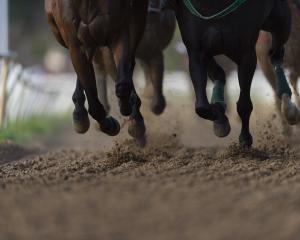But he is certainly the man in charge of the track at Forbury Park, and he could not be more proud of the way the track is handling the racing these days.
McFarlane, who turns 60 on Sunday, has been the caretaker for six winters - ''I count off the winters, as that's our major thing'' - after assisting former caretaker Roger Kingsland for 12 months. Prior to that, he had a number of part-time jobs around the track including looking after the greyhound track for two years.
McFarlane was not from a racing background, but began working in stables from the age of 15.
''I've worked in about 11 different stables from Wyndham to Hamilton to Perth,'' McFarlane said.
Some of his more notable employers included Jim Dalgety, the father of leading trainer Cran Dalgety, and Devine, who asked McFarlane to look after his horses while he was away for three weeks - all the horses bar one.
''Cec went away on holiday and I looked after the place while he was gone but I wasn't allowed to work Lord Module just in case he killed me,'' he said.
Lord Module, the 1979 New Zealand Trotting Cup winner, was a notorious barrier rogue whose high-end speed was matched only by his mental issues.
''In Cec's words, if he laid me out on the track, there was nobody to work the rest of them. He got someone else in to work him and he said if [Lord Module] laid the other guy out on the track, I was there to help him and the other horses still get worked.
''So I wasn't that distressed about not getting to work Lord Module.''
McFarlane has been a lot more hands-on with the Forbury Park track and his enthusiasm for his job is obvious when he explains its recent history.
''Our main priority is the track. We stand and fall on the track,'' he said.
''We try and blade it as often as we can - it definitely gets bladed in the week prior to a race meeting.
''If we bladed it earlier than that, the local trainers would get a bit disgruntled, because they wouldn't be allowed on the inside of the track.''
Nine trainers prepare 17 horses at Forbury Park, so McFarlane and his assistant, Yarlie Hubac, are conscious of making sure their work on the track is in harmony with the trainers' needs.
The track changed six years ago from a chip track, which had caused problems.
''It was pretty uncomfortable and shifty for the horses and it came back in big clumps into the drivers' faces.''
All the chip was bladed out near the end of 2007, and the blades also struck the clay base in an attempt to get some angle to the corners before chip was laid again over the top of the track, but that caused problems on the inside of the track which ''just turned to porridge'' when it rained.
The chip was eventually replaced with a blend of sand which has turned out to be an ''absolutely beautiful racing surface'', McFarlane said.
''The only issues with it is our track is built on reclaimed land, and underneath is all sorts of stuff.''
That ''stuff'' includes quarry dust and white lime, with the dust still visible at times around the back straight.
''We've got to be extremely careful, even when we're using the conditioner.''
McFarlane is full of praise for the Forbury Park Trotting Club committee, who are happy to provide him with the tools needed to produce a top-quality racing surface.
''If I want to get a conditioner, bang, $35,000 - they bought one.
''There are no issues with getting gear that we need to keep the track right which is a big, big plus.''
Forbury Park has established itself as a regular winter harness racing venue, and it pleases McFarlane to see the same horses appearing throughout the chilly winter meetings.
''If you can get horses running good times on bitterly cold nights here in the winter and then still come back next week and the week after, that's the key to a good track.
''To me, that's what we aim for . . . getting those horses back week after week. I'm proud of the track - it's great.''
McFarlane is always trying to improve it, and the corners are in his sights. The track has a steeper camber on the outside than the inside. This creates a small ''V'' shape near the inside, which collects material.
''Because of the V in the track at that point, I'd like to dig that inside out, so the camber runs right down to the pylons, so the inside horses have got the advantage of running on a camber as well. That means they wouldn't be ripping out and causing a cattle track.
''Or we could move the pylons out one metre to meet the existing camber and re-measure the track and move the starting points accordingly.''














